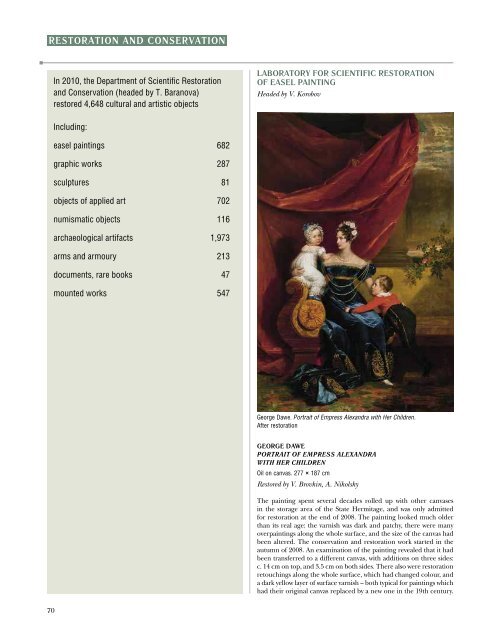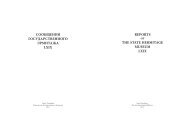The STaTe hermiTage muSeum annual reporT
The STaTe hermiTage muSeum annual reporT
The STaTe hermiTage muSeum annual reporT
Create successful ePaper yourself
Turn your PDF publications into a flip-book with our unique Google optimized e-Paper software.
eSToraTion and conServaTion<br />
In 2010, the Department of Scientific Restoration<br />
and Conservation (headed by T. Baranova)<br />
restored 4,648 cultural and artistic objects<br />
Including:<br />
easel paintings 682<br />
graphic works 287<br />
sculptures 81<br />
objects of applied art 702<br />
numismatic objects 116<br />
archaeological artifacts 1,973<br />
arms and armoury 213<br />
documents, rare books 47<br />
mounted works 547<br />
laBoraTory for ScienTific reSToraTion<br />
of eaSel painTing<br />
Headed by V. Korobov<br />
George Dawe. Portrait of Empress Alexandra with Her Children.<br />
After restoration<br />
george dawe<br />
poRTRaiT of empRess aleXandRa<br />
wiTh heR childRen<br />
Oil on canvas. 277 × 187 cm<br />
Restored by V. Brovkin, A. Nikolsky<br />
<strong>The</strong> painting spent several decades rolled up with other canvases<br />
in the storage area of the State Hermitage, and was only admitted<br />
for restoration at the end of 2008. <strong>The</strong> painting looked much older<br />
than its real age: the varnish was dark and patchy, there were many<br />
overpaintings along the whole surface, and the size of the canvas had<br />
been altered. <strong>The</strong> conservation and restoration work started in the<br />
autumn of 2008. An examination of the painting revealed that it had<br />
been transferred to a different canvas, with additions on three sides:<br />
c. 14 cm on top, and 3.5 cm on both sides. <strong>The</strong>re also were restoration<br />
retouchings along the whole surface, which had changed colour, and<br />
a dark yellow layer of surface varnish – both typical for paintings which<br />
had their original canvas replaced by a new one in the 19th century.<br />
George Dawe. Portrait of Empress Alexandra with Her Children (detail: before restoration; during restoration; after restoration)<br />
<strong>The</strong> technical restoration involved making a new stretcher, straightening<br />
and patching the painting, adding canvas conservation hems<br />
to help keep it in place on the new stretcher. This removed the decrepit<br />
canvas in the corners and rectified the deformities. <strong>The</strong> restoration<br />
of the painting itself started with the cleaning of test areas<br />
from varnish and overpainting. <strong>The</strong> painting and its structure was<br />
studied and described in detail.<br />
<strong>The</strong> opaque layer of yellow varnish with dark retouching was removed<br />
by application of a 1:4 alcohol: pinene solution and tools<br />
such as a brush, a cotton wool pad and a scalpel. As a result, among<br />
other things, the colour of the dress changed from dirty green to<br />
dark blue, while the colour of the canopy changed from brown to<br />
dark red-wine colour. A thinner layer of varnish was re-applied to the<br />
whole surface with the help of ethanol vapours (Pettenkofer process).<br />
<strong>The</strong> painting was covered with a thin layer of megilp, and the<br />
losses were filled in with oil paints with microscopic precision.<br />
Now a formerly lost painting by Dawe, Portrait of Empress Alexandra<br />
with Her Children, will occupy its rightful place in the museum gallery<br />
as a splendid example of the wonderful English portrait painter’s<br />
mature work.<br />
<strong>The</strong> first versions of the portrait of Emperor Nicholas I and Empress<br />
Alexandra with their children were transferred in 1846 to the Romanov<br />
Family Gallery from the Nicholas (Anichkov) Palace, which<br />
probably led to their restoration and enlargement (which may be<br />
linked to the architectural designs for a new gallery and the preparation<br />
of new wall finishing and new frames). Transferring paintings<br />
to a new canvas in order to enlarge the picture was normal practice<br />
for nineteenth-century Russian restorers. It allowed them to avoid<br />
deformities inevitable when restoration painting was joined to the<br />
original layers. <strong>The</strong> reverse side of the new canvas would still bear<br />
the name of the artist along with the place and date of completion.<br />
Our canvas, however, does not have such an inscription, and only<br />
the number 460 bears testimony to the fact that the portrait was<br />
included in the inventory of the Nicholas Palace. It is logical to suppose<br />
that the complex restoration was carried out between 1846 and<br />
1855. Thus, the size of the painting was altered in the 19th century,<br />
making the picture 15 cm higher. It is interesting that the author’s<br />
copies of the portraits of Nicholas and Alexandra are 262 cm high,<br />
which corresponds to the original size of the painting in question.<br />
Thus, it was possible to determine that:<br />
restoratIon anD conserVatIon<br />
– the size of the portrait was enlarged to fit that of the companion<br />
portrait of Nicholas I, and this was done during the nineteenthcentury<br />
restoration;<br />
– the restoration (transferral to a new canvas and altering the size)<br />
took place after the artist’s original copies of both portraits were made,<br />
in the middle of the 19th century but preceding the 1855 inventory<br />
of the Nicholas Palace when the portrait was recorded as No 460;<br />
– the additional pieces of canvas are not original; the colour scheme,<br />
texture and foundation are different from those in the original<br />
painting.<br />
70 71




